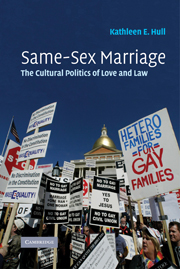Book contents
- Frontmatter
- Contents
- List of tables
- Preface
- Same-sex marriage timeline
- 1 Marriage, culture and law
- 2 Doing the rite thing: cultural practices of commitment
- 3 How do I love thee? Questioning the marriage model
- 4 Making it legal: marriage, law and legality
- 5 Sin or civil right? Debating marriage in the states
- 6 Conclusion: marriage and beyond
- Epilogue
- Appendix A Interview guides
- Appendix B Sample characteristics
- Appendix C Study participants
- Notes
- Court cases
- References
- Index
6 - Conclusion: marriage and beyond
Published online by Cambridge University Press: 05 June 2012
- Frontmatter
- Contents
- List of tables
- Preface
- Same-sex marriage timeline
- 1 Marriage, culture and law
- 2 Doing the rite thing: cultural practices of commitment
- 3 How do I love thee? Questioning the marriage model
- 4 Making it legal: marriage, law and legality
- 5 Sin or civil right? Debating marriage in the states
- 6 Conclusion: marriage and beyond
- Epilogue
- Appendix A Interview guides
- Appendix B Sample characteristics
- Appendix C Study participants
- Notes
- Court cases
- References
- Index
Summary
Love, the strongest and deepest element in all life, the harbinger of hope, of joy, of ecstasy; love, the defier of all laws, of all conventions; love, the freest, the most powerful moulder of human destiny; how can such an all-compelling force be synonymous with that poor little State and Church-begotten weed, marriage?
–Emma Goldman (1910)The meanings and purposes of marriage are ever-changing. The history of marriage features a shift from marriage as a property relationship to marriage as a consensual expression of mutual love. Over the past two centuries, the gender hierarchy that once characterized marriage, in both cultural and legal terms, has largely given way to a new model of equality and negotiated roles in the United States and other Western societies. The role of sexual expression within marriage has also evolved, from a focus on its procreative function to recognition of the value of sexual pleasure in its own right. And most of the social and legal constraints on the choice of a marriage partner have fallen away, including restrictions based on class, religion and, most notably, race (Cott 2000). For some, same-sex marriage appears as the next logical and inevitable step in the continuing change and evolution of the institution of marriage. For others, it represents a dangerous undermining of marriage's basic meanings and functions. Marriage today is contested terrain.
- Type
- Chapter
- Information
- Same-Sex MarriageThe Cultural Politics of Love and Law, pp. 196 - 216Publisher: Cambridge University PressPrint publication year: 2006



